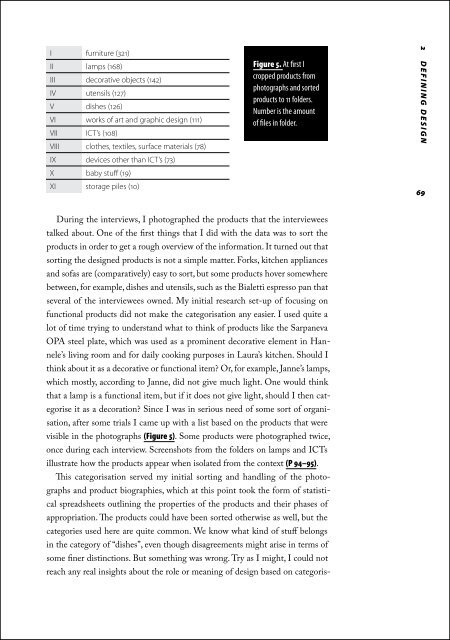Lataa ilmaiseksi
Lataa ilmaiseksi
Lataa ilmaiseksi
You also want an ePaper? Increase the reach of your titles
YUMPU automatically turns print PDFs into web optimized ePapers that Google loves.
I furniture (321)<br />
II lamps (168)<br />
III decorative objects (142)<br />
IV utensils (127)<br />
V dishes (126)<br />
VI works of art and graphic design (111)<br />
VII ICT’s (108)<br />
VIII clothes, textiles, surface materials (78)<br />
IX devices other than ICT’s (73)<br />
X baby stuff (19)<br />
XI storage piles (10)<br />
Figure 5. At first I<br />
cropped products from<br />
photographs and sorted<br />
products to 11 folders.<br />
Number is the amount<br />
of files in folder.<br />
2 D E F I N I N G D E S I G N<br />
69<br />
During the interviews, I photographed the products that the interviewees<br />
talked about. One of the first things that I did with the data was to sort the<br />
products in order to get a rough overview of the information. It turned out that<br />
sorting the designed products is not a simple matter. Forks, kitchen appliances<br />
and sofas are (comparatively) easy to sort, but some products hover somewhere<br />
between, for example, dishes and utensils, such as the Bialetti espresso pan that<br />
several of the interviewees owned. My initial research set-up of focusing on<br />
functional products did not make the categorisation any easier. I used quite a<br />
lot of time trying to understand what to think of products like the Sarpaneva<br />
OPA steel plate, which was used as a prominent decorative element in Hannele’s<br />
living room and for daily cooking purposes in Laura’s kitchen. Should I<br />
think about it as a decorative or functional item? Or, for example, Janne’s lamps,<br />
which mostly, according to Janne, did not give much light. One would think<br />
that a lamp is a functional item, but if it does not give light, should I then categorise<br />
it as a decoration? Since I was in serious need of some sort of organisation,<br />
after some trials I came up with a list based on the products that were<br />
visible in the photographs (Figure 5). Some products were photographed twice,<br />
once during each interview. Screenshots from the folders on lamps and ICTs<br />
illustrate how the products appear when isolated from the context (P 94–95).<br />
This categorisation served my initial sorting and handling of the photographs<br />
and product biographies, which at this point took the form of statistical<br />
spreadsheets outlining the properties of the products and their phases of<br />
appropriation. The products could have been sorted otherwise as well, but the<br />
categories used here are quite common. We know what kind of stuff belongs<br />
in the category of “dishes”, even though disagreements might arise in terms of<br />
some finer distinctions. But something was wrong. Try as I might, I could not<br />
reach any real insights about the role or meaning of design based on categoris-
















